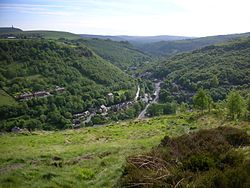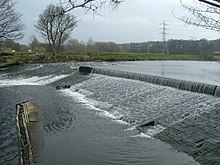River Calder, West Yorkshire
| Calder | |
|---|---|
 View of the Calder Valley west of Hebden Bridge | |
| Location | |
| Country | England |
| Metropolitan County | West Yorkshire |
| Towns/Cities | Todmorden,Hebden Bridge,Sowerby Bridge,Elland,Brighouse,Mirfield,Dewsbury,Wakefield |
| Physical characteristics | |
| Source | Heald Moor |
| • location | betweenHolme ChapelandCornholme,Lancashire |
| • elevation | 1,312 ft (400 m) |
| Mouth | |
• location | River Aire,Castleford |
| Length | 45 mi (72 km) |
TheRiver Calderis a river inWest Yorkshire,inNorthern England.
The Calder rises on Heald Moor in Lancashire close to the source ofanother river with the same name,and then flows east into West Yorkshire through green countryside, former woollen-mill villages and towns before joining theRiver AirenearCastleford.
The river's valley is generally known as theCalder Valley.The nameCalderdaleusually refers to the large urban and rural borough (centred onHalifax) through which the upper river flows. The lower reaches flow through the boroughs ofKirklees(based on Huddersfield) andWakefield.However, the river does not flow through the centres of Halifax and Huddersfield, which are on the Calder's main tributaries,Hebble Brookand theRiver Colnerespectively. The only large town centres through which the Calder flows areBrighouse,Mirfield,Dewsburyand the city ofWakefield.
The river itself is only navigable in short sections, but these sections are connected by artificial "cuts" (e.g. Horbury Cut) to form theCalder and Hebble Navigation,a popular leisure waterway which is part of the connectedinland waterwaynetwork of England and Wales.
Etymology[edit]
The word ultimately derives from theBrythonic language,with most scholars agreeing that the name is a compound of two elements related to theModern Welshwordscaled(hard) anddwr(water). However, it is still a subject of debate if the hard element refers to the river's bed, or figuratively to the strength of its currents. As such two separate meanings are commonly derived with 'hard (or violent) water',[1]orriver of stones[2]being commonly given translations.
The name 'Calder' is common in Northern Britain, being found in various places across Lancashire and Yorkshire, as well asCalderstones,Liverpool,East CalderandWest CaldernearEdinburghandCalderwoodnearGlasgow,and as the name of the ScottishClan Calder.[3]The late survival of Celtic speaking peoples in the vicinity of the river Calder is perhaps evidenced in the names of villages such asWalsden,in upper Calderdale, which probably derives from*WalhazDene, meaning "Valley of the" Welsh "('Welsh' being what the Anglo-Saxons called the native Celts who would have spokenOld Welsh).[4]
Geography[edit]
The river rises approximately 1,300 feet (400 m) above sea level at Heald Moor,[5]north-west ofTodmorden,and drains an area of 369 square miles (957 km2). It flows for a distance of around 45 miles (72 km) throughCornholme,Todmorden,Eastwood,Hebden Bridge,Mytholmroyd,Luddendenfoot,Sowerby Bridge,Copley,Elland,Brighouse,Mirfield,Dewsbury,Horbury Bridgeand on to Wakefield.
The catchment lies onCarboniferousrocks ofMillstone Grit,and is heavily reservoired, with 39reservoirslicensed to provide water. The river is joined by Hebden Water at Hebden Bridge, and by the River Ryburn at Sowerby Bridge; it is linked to the town ofRochdale,Greater Manchesteracross thePenninesvia theRochdale Canal.
For much of its length, the Calder is canalised and becomes theCalder and Hebble Navigation.It is also part of theAire and Calder Navigation,and to the east ofCastleford,[6]it merges into theRiver Aire,going on to join theHumber Estuaryand theNorth Sea.
History[edit]

The river was central to establishment of the textile industries in the local area, and flows through the area known as the YorkshireHeavy Woollen District.Many major mills were constructed along its banks, particularly atDewsburyandWakefield,but also in the smaller communities ofBrighouse,Hebden Bridge,Sowerby BridgeandTodmorden,as well as along its tributaries: the Hebble atHalifax,and the Colne atHuddersfield.The mills in theUpper Calder Valleyspecialised in cotton weaving, with some cotton spinning, while those in the lower part of the valley specialised in wool and shoddy. Some of these structures still exist as listed buildings, although the large scale production ofyarnandtextilehas now ceased.
The river formed an important transportation system for raw materials and the products of the mills, particularly prior to the development of other infrastructures such asroadandrailwaylinks to the area. At many places, the river is not navigable because of weirs or the shallow depth, and passage for boats was made by the creation of cuts where boats are able to enter theCalder and Hebble Navigation.Work began to make the Calder navigable above Wakefield in 1758.
Wakefield'smedievalnine-arched bridge is 320 feet (98 m) long, was built insandstonebetween 1342 and 1356, and replaced an earlier wooden structure on the site of an ancient ford. Thechantry chapelon the bridge was licensed in 1356. At Wakefield, a variety of formermillbuildings are currently being redeveloped to create a Waterfront project which will combine residential housing, offices, galleries and public spaces.The Hepworth Wakefieldopened in 2011.
In the late 1830s and early 1840s, the River Calder was diverted at Kirkthorpe to aid the building of the railway betweenWakefield KirkgateandNormanton.This also straightened out one of the larger curves in the river and was a cheaper option than building bridges to span the river.[7][8][9]In 2015 a 100 kW hydro installation and fish pass was completed at Whalley Weir on the River Calder in Whalley. The micro hydroelectric generating plant uses a variable speed Archimedean screw.[10][11]The weir atKirkthorpewas adapted in 2017 to be a hydroelectric generating station, with a capacity of 500 kWh.[12]
Filming location[edit]
The valley's historic towns and cities have attracted film and television productions. Several films and television series have been filmed in the area, particularly around the town ofHuddersfield.[13][14]For example, portions of the BBC television seriesHappy Valley(2014) were filmed in Huddersfield; in addition to exteriors, some of the studio filming was done at North Light Film Studios at Brookes Mill, Huddersfield. As well, interiors for the BBC'sJamaica Inn,for the BBC'sRemember Meand for ITV seriesBlack Work,were also filmed at the studios.[15][16][17][18]Many of the exteriors of the BBC seriesJericho(2016) were filmed at the nearby Rockingstone Quarry and some interior work was done at North Light Film Studios.[19]
The TV seriesThe Gallows Poletakes place in Calder Valley in the 1760s, and is partially filmed inHeptonstall.[20]
Environmental[edit]
Wildlife and fish[edit]
Until the 19th century, the Calder was home to large numbers ofsalmonbut pollution from the textile and chemical industries along its banks led to the death of the salmon population by the mid 19th century. The last salmon on record was caught at Wakefield in 1850, however there is evidence that they are returning, with sightings on the lower river at Castleford in 2008[21]and alleged catchings much further upstream. AroundHuddersfield,MirfieldandWakefieldare popular areas for coarse fishing,roach,perch,chub,dace,minnows,gudgeon,pike,breamandtrout.The areas upstream of Dewsbury are quickly becoming cleaner and more suited to game and specialised rivercyprinidslikebarbel,as well as general coarse fish that are also doing well.
Alongside the river are fourSites of Special Scientific Interest.
Recent improvements in reducing the amount of pollution have led to the return of native wildlife, such as theotterandkingfisherto stretches of the river.
Kingfishers are easily spotted (all year round, due to its orange underbelly) all the way up and down the river's course and are quite numerous around the Mirfield area.
Pollution[edit]
The river has been heavily polluted by the textile industry, and, more recently, chemical works along its banks.
Close to its source at Heald Foot, the water is polluted by the remains of past opencastminingactivities and a landfill site. This has also led to a significant amount ofsoil erosion,with major mudslides into the river and its tributaries in 1947, 1982, 1991 and 2001.
As the river reached Huddersfield, the traditionaltextileindustries created a considerable amount of water pollution, particularly through the processes involved in the production of syntheticdyesand in scouring the wool clean. The enormous growth of the population over the last hundred years (currently over 800,000 people live within the river's catchment) has caused other problems in relation tosewage.Another major source of pollution until recently came from a disused tar distillery inMirfield.[22]
In the middle 1950s the river was so polluted by dyeworks in the middle reaches between Todmorden and Sowerby Bridge, that it ran different opaque colours from day to day. On Easter Monday, after a long weekend holiday shutdown, the water cleared and the river bottom could actually be seen, looking like a grey wool blanket. Tighter controls during the 1950s led to an improvement in water quality, and presently organisations such as Calder Future are working collaboratively with local industries andYorkshire Waterto promote more responsible use of the river and to re-establish lost wildlife along its banks.
Flooding and flood defences[edit]
The river has a history of flooding, mainly due to the high sides of its banks in its earlier stages, which cause rapid runoff of water following heavy rain. Much of the lower part of the river has beenurbanised,therefore trapping flowing water within the engineered river channels. Fast flows of water cause the deposition of sediment collected from the river banks, raising the river height further.
A variety of flood defences are in operation along the Calder Valley to prevent the recurrence of floods which devastated communities in the early part of this century. At Wakefield, for example, the lake atPugneys Country Parkis used as an overflow for the river in order to protect the town.
The recently regenerated Wakefield Waterfront area is defended by one of the most sophisticated flood defence systems in Europe. This complex of computer controlled automatic flood barriers are housed below ground and rise automatically when a flood threat is detected.
Leisure use of the river[edit]
The river is host to a variety of watersports activities:
- acanoeingcentre at Sowerby Bridge
- waterskiingin gravel pits at Cromwell Bottom
- watersports andanglingat Pugneys Country Park
- the use of leisure craft and narrowboats along the lower stretch of the river where navigation is made easier through the canals built during theIndustrial Revolution
- Walking routes along thePennine WayandCalderdale Way
- Angling in areas is distributed between the following; Bradford No.1 angling association, Mirfield AC, Thornhill AC, and Wakefield AC. Some stretches are free and only require a valid Environment agency rod licence
See also[edit]
- Rivers of the United Kingdom
- List of crossings of the River Calder, West Yorkshire
- Upper Calder Valley
- Murder of Lindsay Rimer,unsolved 1994 case of a 13-year-old girl found murdered in the river
References[edit]
- ^Watts, Victor, ed. (2010). "Calder".The Cambridge Dictionary of English Place-Names.Cambridge University Press.
- ^"Fact File".kirklees-ednet.org.uk.Retrieved23 September2009.
- ^Price, Glanville (2000).Languages in Britain & Ireland.Oxford: Blackwell Publishers. p. 74.ISBN9780631215806.
- ^Watts, Victor, ed. (2010). "Walsden".The Cambridge Dictionary of English Place-Names.Cambridge University Press.
- ^53°43′19″N2°10′23″W/ 53.722°N 2.173°W
- ^53°43′55″N1°21′32″W/ 53.732°N 1.359°W
- ^"Stanley History Online - Stanley Ferry History".stanleyhistoryonline.Retrieved23 July2019.
- ^"Plan of Kirkthorpe dam and cut diversion of the river Calder".discovery.nationalarchives.Retrieved23 July2019.
- ^Herepath, John (1839). "Reports".Herepath's Railway and Commercial Journal.6.Charing Cross: James Wyld: 245.OCLC221127091.
- ^"Whalley Hydro powers up".Premier Construction News.13 January 2015.Retrieved6 February2021.
- ^"Whalley Community Hydro | Community Renewable Energy Scheme".2 August 2015. Archived fromthe originalon 2 August 2015.Retrieved6 February2021.
- ^Snowden, Ros (19 July 2019)."Yorkshire green energy firm snapped up in multi-million pound deal".The Yorkshire Post.Retrieved24 July2019.
- ^"Productions at North Light Film Studios".North Light Film Studios.North Light Film Studios. 2017.Retrieved10 February2017.
- ^"Film & TV".Examiner.Huddersfield. 29 October 2016.Retrieved10 February2017.
- ^Ballinger, Lauren (5 December 2014)."North Light Film Studios - Remember Me filming locations".Examiner.Huddersfield.Retrieved10 February2017.
- ^Rees, Caroline (3 November 2013)."Sally Wainwright: not the same old".The Guardian.Retrieved19 January2014.
- ^Bremner, Jade (11 December 2013)."Last Tango in Halifax actress Sarah Lancashire begins shooting new crime drama in Yorkshire".Radio Times.Retrieved19 January2014.
- ^"Creative England provides filming location and crew support to new BBC drama Happy Valley when filming in Yorkshire".Creative England.29 April 2014.Retrieved12 June2014.
- ^ Gildea, Samantha (1 February 2016)."Jericho filming locations".Examiner.Huddersfield.Retrieved10 February2017.
- ^Vinter, Robyn (16 June 2023)."'Definitely a lot busier': TV show lures visitors to coin gang's Yorkshire home ".The Guardian.Retrieved9 March2024.
- ^"Return of the Salmon".29 January 2008.Retrieved14 August2010.
- ^"A good clean up".EHJ online.2 January 2005. Archived fromthe originalon 26 May 2005.
Sources[edit]
- Kirklees site about the River Calder
- Rivers Info with imagesRetrieved 14 December 2007.
